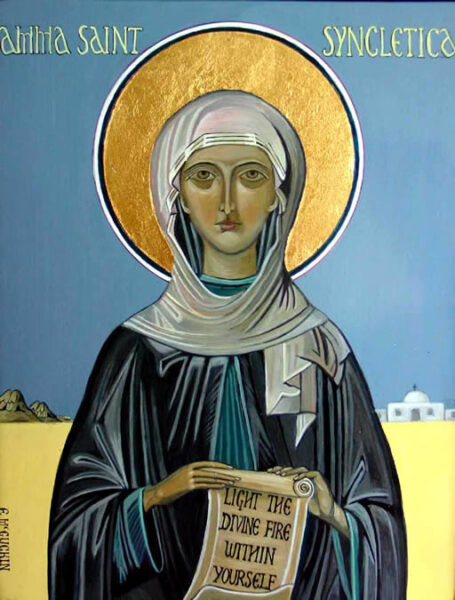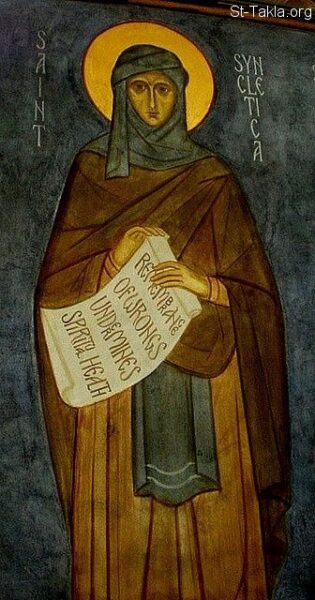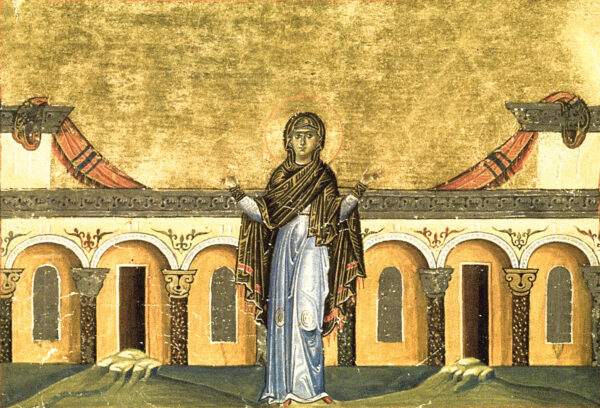
Last updated: January 24, 2025
Amma Syncletica was part of a monastic tradition that was established primarily in the desert areas around Jerusalem and Alexandria. Desert Mothers were women, known as ammas or “spiritual mothers,” who lived as Christian ascetics in the fourth and fifth centuries CE. Ammas were women who had achieved a spiritual maturity and wisdom, actively developed during their withdrawal from mainstream society. These women gathered together in monastic communities, but there were also some who lived as hermits. For these early Christian women, one appeal of living in the desert was the freedom they could experience that was not available to them in the usual female domains of the culture.
As Christianity became more mainstream, women were attracted to the ascetic life. There they could participate in prophetic and monastic leadership, in spite of male church leaders who were uncomfortable with women in public roles. The Desert Mothers were well known at the time and were often sought out as teachers and spiritual directors. Many lived in remote and hostile environments that enabled them to build up inner strength and to develop a life completely dependent on God alone.

Amma Syncletica of Alexandria, Amma Theodora of Alexandria, and Amma Sarah of the Desert were the most prominent and best known ammas. Some of their sayings were included in Sayings of the Desert Fathers, a book of quotes, mainly from male abbas or “spiritual fathers,” that provides wisdom and insight into a desert spirituality. Of these three women whose voices were included, Amma Syncletica was quoted most often. Twenty-seven of her sayings were recorded, and her biography was written by Pseudo Anthanisius in the fifth century. Mary of Egypt, another woman who lived as a desert ascetic, in the late fifth or early sixth century CE, is also considered by some to be an example of a Desert Mother.
Despite her biography, as with all of the desert mothers, there are not a lot of details available about the life of Amma Synclectia (380-470 CE). She was born to a wealthy family from Macedonia that had moved to Alexandria. Her name is derived from the Greek language meaning “heavenly assembly,” and she began fasting and praying in solitude as a young girl. Amma Syncletica was well educated and was known to have been familiar with the writings of Evagrius Ponticus. She is also said to have been quite beautiful, but continually rebuffed her suitors, claiming that she was betrothed to the Heavenly Bridegroom.
When her parents died, she sold everything they owned and gave the money to the poor. Cutting her hair as a symbol of her consecration, and taking her blind sister with her, Amma Syncletica moved into the cemetery outside of Alexandria to live as an ascetic. There, she was pursued by other women who were interested in her teachings. At first, Amma Syncletica refused to break her silence to teach the other women, primarily out of a stance humility. She was finally persuaded to give in to their requests as an offering of charity, and gradually a community of women disciples became established around her. Amma Syncletica revealed to them the wisdom and spiritual knowledge that she received from the Holy Spirit.

Amma Syncletica was gifted with discernment and became quite skilled in counseling the women who gathered around her. Some women would arrive enthusiastically looking for a monastic life, but were not fully prepared to live such a rigorous and ascetic desert life. Amma Syncletica was able to help them discern how to use their gifts in other ways.
Although the details of her life are scarce, it’s possible to catch a glimpse of Amma Syncletica’s life from her sayings. Since the desert mothers lived so early in the history of Christianity, they had no rule of life that later monastic communities would have. Instead her teachings focused on experiences of kindness and humility, and have much to say to us, even today.
Here is the quote from Amma Syncletica that I have chosen to include in my book and the acrylic monoprint that I made to go with it.
If you have begun to act well, do not turn back through constraint of the enemy, for through your endurance, the enemy is destroyed. Those who put out to sea at first sail with a favorable wind; then the sails spread, but later the winds become adverse. Then the ship is tossed by the waves and is no longer controlled by the rudder. But when in a little while there is a calm, and the tempest dies down, then the ship sails on again. So it is with us, when we are driven by the spirits who are against us; we hold to the cross as our sail and so we can set a safe course.
Amma Syncletica (fourth century CE)
In the last three years of her life, Amma Syncletica was afflicted with physical sickness, possibly a form of cancer. Her body began to break down, and it’s written that she knew the hour of her death three days before it came. At that time, it is said that she had a mystical vision of angels and paradise (“…the watchful hovering of angels, the encouragement of holy maidens for her passage, the radiance of ineffable light, and a paradisal realm…”) before she died. Amma Syncletica’s feast day is celebrated on January 5.
UPDATE: This blog post was updated on January 24, 2025 to attribute the icon in Figure 1 to Eileen McGuckin.

Reference 1: Swan, Laura, “The Forgotten Desert Mothers: Sayings, Lives, and Stories of Early Christian Women,” Paulist Press, Mahwah, NJ, 2001.
Reference 2: Ward, Benedicta, “The Sayings of the Desert Fathers,” Cistercian Publications, Kalamazoo, MI, 1984.
Reference 3: Earle, Mary, “The Desert Mothers: Spiritual Practices from the Women of the Wilderness,” Morehouse Publishing, Harrisburg, NY, 2007.
Reference 4: Forman, Mary, “Praying with the Desert Mothers, Liturgical Press, Collegeville, MN, 2005.
Reference 5: Chittister, Joan, “In God’s Holy Light: Wisdom from the Desert Monastics,” Franciscan Media, Cincinnati OH, 2015.
Reference 6: Father Brad, “The Desert Mothers: Amma Syncletica,” blog post at Desert Spirit Press website, August 26, 2022, https://desertspiritpress.net/2022/08/26/the-desert-mothers-amma-syncletica/.
Reference 7: “Amma Syncletica of Alexandria – Part 1,” blog post at Wind Ministries website, https://www.windministries.ca/blog/amma-syncletica-of-alexandria-part-1.
Reference 8: “Amma Syncletica of Alexandria – Part 2,” blog post at Wind Ministries website, https://www.windministries.ca/blog/amma-syncletica-of-alexandria-part-2.
Image 1: Icon of Amma Syncletica, written by Eileen McGuckin.
Image 2: Saint Syncletica, fresco by Elder Sophrony Sakharov at the refectory of St John the Baptist Monastery in Essex, blog post, January 5, 2011.
Image 3: The Cross as Our Sail, Julie Henkener, 2024.
Image 4: Miniature of Saint Syncletica, illuminated manuscript Menologion of Basil II, circa 1000 CE, Vat. gr. 1613, Vatican Library, Rome.















2 Comments
Leave your reply.